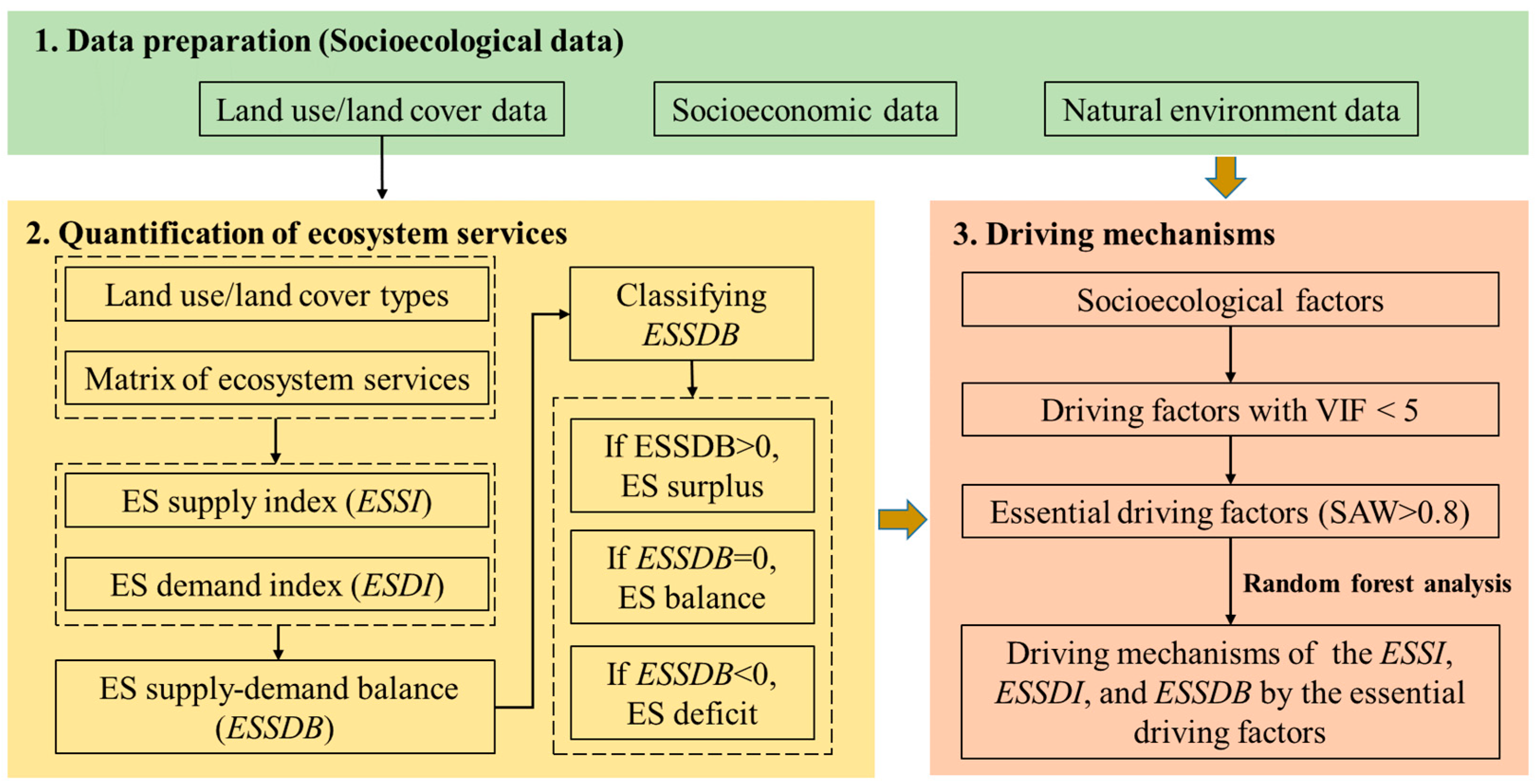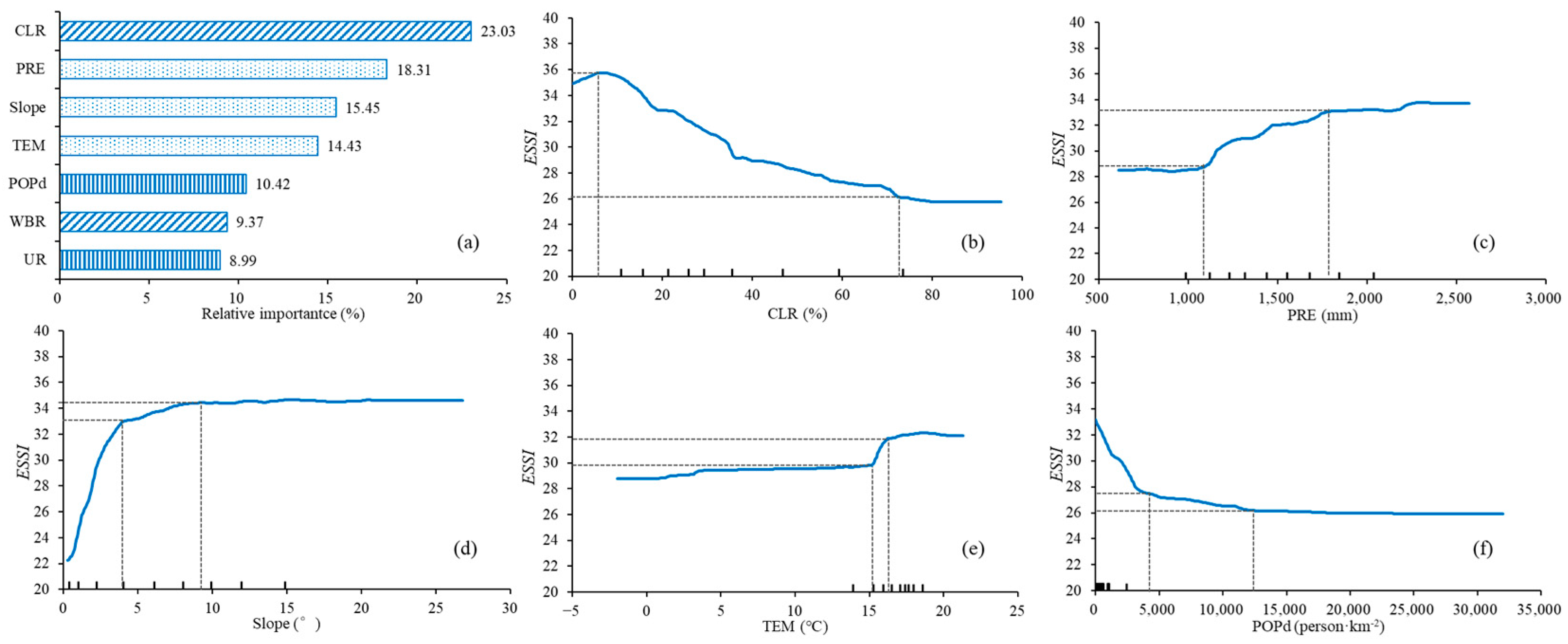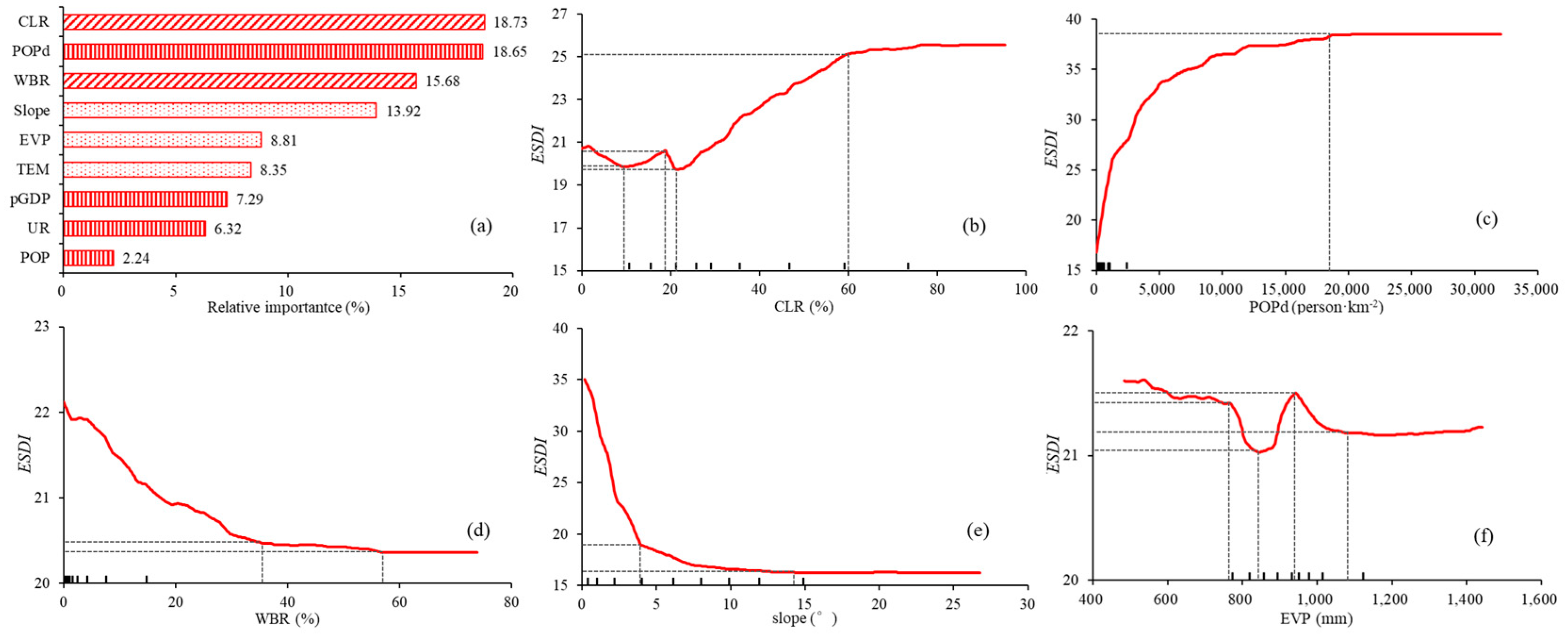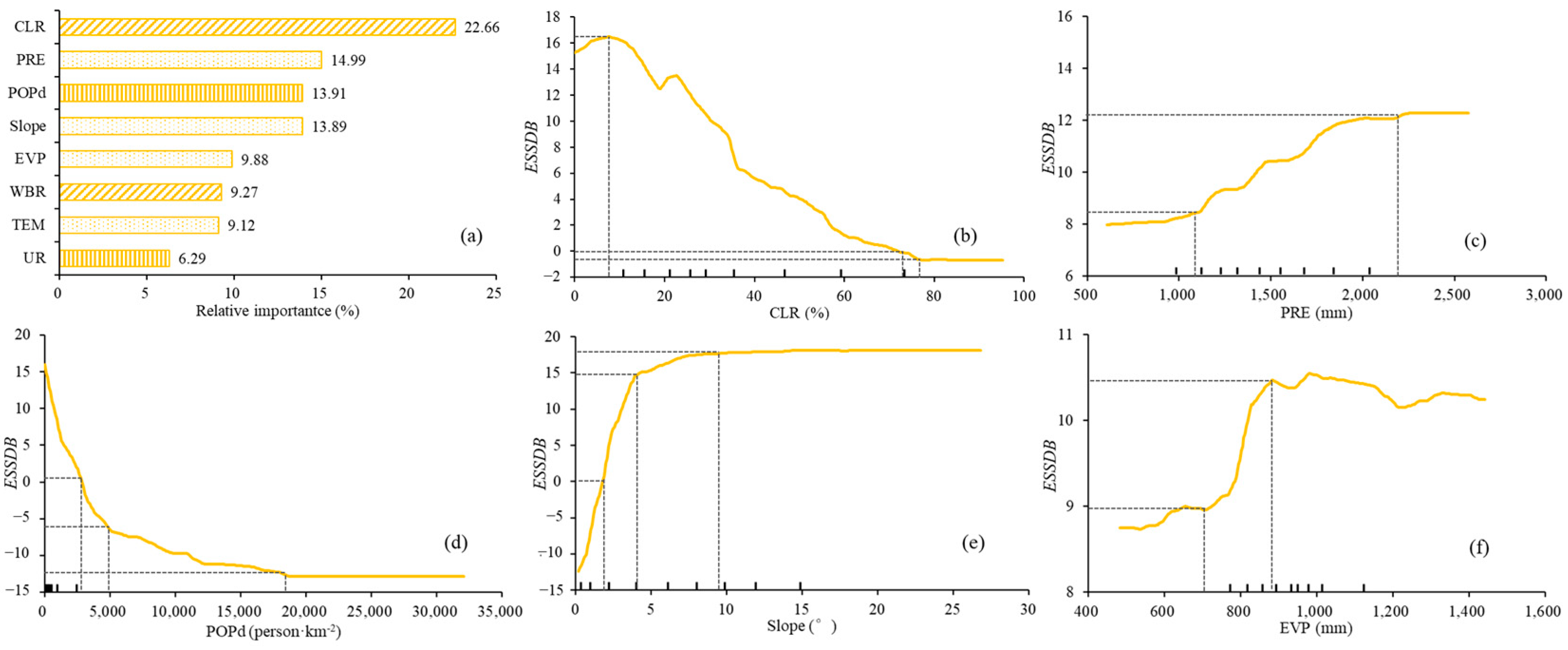Exploring the Response of Ecosystem Services to Socioecological Factors in the Yangtze River Economic Belt, China
Abstract
:1. Introduction
2. Materials and Methods
2.1. Study Area
2.2. Theoretical Framework
2.3. Data Preparation
2.4. Quantification of Ecosystem Services
2.5. Mechanisms Driving Ecosystem Services
2.5.1. Driving Factor Selection
2.5.2. Random Forest Analysis
3. Results
3.1. Spatial Distribution of Ecosystem Services in the YREB
3.2. Mechanisms Driving the ES Supply, Demand, and Supply–Demand Balance
3.2.1. Driving Factors
3.2.2. Accuracy of the Random Forest Model
3.2.3. Socioecological Factors for the ES Supply, Demand, and Supply–Demand Balance
4. Discussion
4.1. Influence of Socioecological Factors on Ecosystem Services
4.2. Response Processes of Ecosystem Services to Socioecological Factors
4.3. Implications for Ecosystem Management
4.4. Limitations and Future Work
5. Conclusions
Supplementary Materials
Author Contributions
Funding
Data Availability Statement
Acknowledgments
Conflicts of Interest
References
- Costanza, R.; d’Arge, R.; de Groot, R.; Farber, S.; Grasso, M.; Hannon, B.; Limburg, K.; Naeem, S.; O’Neill, R.V.; Paruelo, J.; et al. The Value of the World’s Ecosystem Services and Natural Capital. Nature 1997, 387, 253–260. [Google Scholar] [CrossRef]
- Costanza, R.; de Groot, R.; Braat, L.; Kubiszewski, I.; Fioramonti, L.; Sutton, P.; Farber, S.; Grasso, M. Twenty Years of Ecosystem Services: How far Have We Come and How far do We Still Need to Go? Ecosyst. Serv. 2017, 28, 1–16. [Google Scholar] [CrossRef]
- Burkhard, B.; Kroll, F.; Nedkov, S.; Muller, F. Mapping Ecosystem Service Supply, Demand and Budgets. Ecol. Indic. 2012, 21, 17–29. [Google Scholar] [CrossRef]
- Baró, F.; Palomo, I.; Zulian, G.; Vizcaino, P.; Haase, D.; Gómez-Baggethun, E. Mapping Ecosystem Service Capacity, Flow and Demand for Landscape and Urban Planning: A Case Study in the Barcelona Metropolitan Region. Land Use Policy 2016, 57, 405–417. [Google Scholar] [CrossRef]
- Kang, J.M.; Li, C.L.; Zhang, B.L.; Zhang, J.; Li, M.R.; Hu, Y.M. How Do Natural and Human Factors Influence Ecosystem Services Changing? A Case Study in Two Most Developed Regions of China. Ecol. Indic. 2023, 146, 109891. [Google Scholar] [CrossRef]
- Sun, Y.; Zhao, T.Y.; Cotella, G.; Liu, Y.S. Ecosystem Services Supply and Demand Mismatches and Effect Mechanisms in the Mixed Landscapes Context. Sci. Total Environ. 2023, 885, 163909. [Google Scholar] [CrossRef]
- Zhang, Z.M.; Gao, J.F.; Fan, X.Y.; Lan, Y.; Zhao, M.S. Response of Ecosystem Services to Socioeconomic Development in the Yangtze River Basin, China. Ecol. Indic. 2017, 72, 481–493. [Google Scholar] [CrossRef]
- Czúcz, B.; Arany, I.; Potschin-Young, M.; Bereczki, K.; Kertész, M.; Kiss, M.; Aszalós, R.; Haines-Young, R. Where Concepts Meet the Real World: A Systematic Review of Ecosystem Service Indicators and Their Classification Using CICES. Ecosyst. Serv. 2018, 29, 145–157. [Google Scholar] [CrossRef]
- Shen, J.S.; Li, S.C.; Wang, H.; Wu, S.Y.; Liang, Z.; Zhang, Y.T.; Wei, F.L.; Li, S.; Ma, L.; Wang, Y.Y.; et al. Understanding the Spatial Relationships and Drivers of Ecosystem Service Supply-demand Mismatches Towards Spatially-targeted Management of Social-ecological System. J. Clean. Prod. 2023, 406, 136882. [Google Scholar] [CrossRef]
- Liu, H.Y.; Xiao, W.F.; Zhu, J.H.; Zeng, L.X.; Li, Q. Urbanization Intensifies the Mismatch between the Supply and Demand of Regional Ecosystem Services: A Large-scale Case of the Yangtze River Economic Belt in China. Remote Sens. 2022, 14, 5147. [Google Scholar] [CrossRef]
- Hou, W.Y.; Hu, T.Z.; Yang, L.P.; Liu, X.C.; Zheng, X.Y.; Pan, H.Y.; Zhang, X.H.; Xiao, S.J.; Deng, S.H. Matching Ecosystem Services Supply and Demand in China’s Urban Agglomerations for Multiple-scale Management. J. Clean. Prod. 2023, 420, 138351. [Google Scholar] [CrossRef]
- Kong, L.; Wu, T.; Xiao, Y.; Xu, W.; Zhang, X.; Daily, G.C.; Ouyang, Z. Natural Capital Investments in China Undermined by Reclamation for Cropland. Nat. Ecol. Evol. 2023, 7, 1771–1777. [Google Scholar] [CrossRef] [PubMed]
- Wu, J.S.; Fan, X.N.; Li, K.Y.; Wu, Y.W. Assessment of Ecosystem Service Flow and Optimization of Spatial Pattern of Supply and Demand Matching in Pearl River Delta, China. Ecol. Indic. 2023, 153, 110452. [Google Scholar] [CrossRef]
- Zeng, J.; Cui, X.Y.; Chen, W.X.; Yao, X.W. Impact of Urban Expansion on the Supply-demand Balance of Ecosystem Services: An Analysis of Prefecture-level Cities in China. Environ. Impact. Assess. Rev. 2023, 99, 107003. [Google Scholar] [CrossRef]
- Cao, T.G.; Yi, Y.J.; Liu, H.X.; Xu, Q.; Yang, Z.F. The Relationship between Ecosystem Service Supply and Demand in Plain Areas Undergoing Urbanization: A Case Study of China’s Baiyangdian Basin. J. Environ. Manag. 2021, 289, 112492. [Google Scholar] [CrossRef]
- Li, J.Y.; Geneletti, D.; Wang, H.C. Understanding Supply-demand Mismatches in Ecosystem Services and Interactive Effects of Drivers to Support Spatial Planning in Tianjin Metropolis, China. Sci. Total Environ. 2023, 895, 165067. [Google Scholar] [CrossRef] [PubMed]
- Peng, J.; Wang, X.; Liu, Y.; Zhao, Y.; Xu, Z.; Zhao, M.; Qiu, S.; Wu, J. Urbanization Impact on the Supply-demand Budget of Ecosystem Services: Decoupling Analysis. Ecosyst. Serv. 2020, 44, 101139. [Google Scholar] [CrossRef]
- Bryan, B.A.; Ye, Y.Q.; Zhang, J.E.; Connor, J.D. Land-use Change Impacts on Ecosystem Services Value: Incorporating the Scarcity Effects of Supply and Demand Dynamics. Ecosyst. Serv. 2018, 32, 144–157. [Google Scholar] [CrossRef]
- Wang, X.Z.; Wu, J.Z.; Liu, Y.L.; Hai, X.Y.; Shanguan, Z.P.; Deng, L. Driving Factors of Ecosystem Services and Their Spatiotemporal Change Assessment Based on Land Use Types in the Loess Plateau. J. Environ. Manag. 2022, 311, 114835. [Google Scholar] [CrossRef]
- Schirpke, U.; Tasser, E.; Borsky, S.; Braun, M.; Eitzinger, J.; Gaube, V.; Getzner, M.; Glatzel, S.; Gschwantner, T.; Kirchner, M.; et al. Past and Future Impacts of Land-use Changes on Ecosystem Services in Austria. J. Environ. Manag. 2023, 345, 118728. [Google Scholar] [CrossRef]
- Li, J.; Jiang, H.; Bai, Y.; Alatalo, J.M.; Li, X.; Jiang, H.; Liu, G.; Xu, J. Indicators for Spatial-temporal Comparisons of Ecosystem Service Status Between Regions: A Case Study of the Taihu River Basin, China. Ecol. Indic. 2016, 60, 1008–1016. [Google Scholar] [CrossRef]
- Li, J.H. Identification of Ecosystem Services Supply and Demand and Driving Factors in Taihu Lake Basin. Environ. Sci. Pollut. Res. 2022, 29, 29735–29745. [Google Scholar] [CrossRef] [PubMed]
- Elliot, T.; Goldstein, B.; Gomez-Baggethun, E.; Proenca, V.; Rugani, B. Ecosystem Service Deficits of European Cities. Sci. Total Environ. 2022, 837, 155875. [Google Scholar] [CrossRef] [PubMed]
- Dabašinskas, G.; Sujetovienė, G. Spatial and Temporal Changes in Supply and Demand for Ecosystem Services in Response to Urbanization: A Case Study in Vilnius, Lithuania. Land 2024, 13, 454. [Google Scholar] [CrossRef]
- Wolff, S.; Schulp, C.J.E.; Verburg, P.H. Mapping Ecosystem Services Demand: A Review of Current Research and Future Perspectives. Ecol. Indic. 2015, 55, 159–171. [Google Scholar] [CrossRef]
- Zhang, J.; Duan, Y.; Zhou, S.; Huang, Y. Evaluation of the Effectiveness of Water Ecological Restoration Based on the Relationship between the Supply and Demand of Ecological Products—A Case Study of the Yellow River Delta. Land 2023, 12, 2093. [Google Scholar] [CrossRef]
- Xu, M.J.; Feng, Q.; Zhang, S.R.; Lv, M.; Duan, B.L. Ecosystem Services Supply-Demand Matching and Its Driving Factors: A Case Study of the Shanxi Section of the Yellow River Basin, China. Sustainability 2023, 15, 11016. [Google Scholar] [CrossRef]
- Wu, J.; Guo, X.; Zhu, Q.; Guo, J.X.; Han, Y.; Zhong, L.; Liu, S.Y. Threshold Effects and Supply-demand Ratios Should Be Considered in the Mechanisms Driving Ecosystem Services. Ecol. Indic. 2022, 142, 109281. [Google Scholar] [CrossRef]
- Yang, M.H.; Zhao, X.N.; Wu, P.T.; Hu, P.; Gao, X.D. Quantification and Spatially Explicit Driving Forces of the Incoordination Between Ecosystem Service Supply and Social Demand at a Regional Scale. Ecol. Indic. 2022, 137, 108764. [Google Scholar] [CrossRef]
- Zhai, T.; Ma, Y.; Fang, Y.; Chang, M.; Huang, L.; Ma, Z.; Li, L.; Zhao, C. Research on the Optimization of Urban Ecological Infrastructure Based on Ecosystem Service Supply, Demand, and Flow. Land 2024, 13, 208. [Google Scholar] [CrossRef]
- Peng, L.X.; Zhang, L.W.; Li, X.P.; Wang, Z.Z.; Wang, H.; Jiao, L. Spatial Expansion Effects on Urban Ecosystem Services Supply-Demand Mismatching in Guanzhong Plain Urban Agglomeration of China. J. Geogr. Sci. 2022, 325, 806–828. [Google Scholar] [CrossRef]
- Fedele, G.; Locatelli, B.; Djoudi, H.; Colloff, M.J. Reducing Risks by Transforming Landscapes: Cross-scale Effects of Land-use Changes on Ecosystem Services. PLoS ONE 2018, 13, e0195865. [Google Scholar] [CrossRef]
- Liu, J.; Wan, J.; Li, S.; Shen, Y.; Han, W.; Liu, G. Spatial–Temporal Pattern of Coordination between the Supply and Demand for Ecosystem Services in the Lhasa River Basin. Land 2024, 13, 510. [Google Scholar] [CrossRef]
- Castro, A.J.; Verburg, P.H.; Martín-López, B.; Garcia-Llorente, M.; Cabello, J.; Vaughn, C.C.; López, E. Ecosystem Service Trade-offs from Supply to Social Demand: A Landscape-scale Spatial Analysis. Landsc. Urban Plan. 2014, 132, 102–110. [Google Scholar] [CrossRef]
- Zhang, J.; Guo, W.; Cheng, C.J.; Tang, Z.Y.; Qi, L.H. Trade-offs and Driving Factors of Multiple Ecosystem Services and Bundles under Spatiotemporal Changes in the Danjiangkou Basin, China. Ecol. Indic. 2022, 144, 109550. [Google Scholar] [CrossRef]
- Zhao, Y.H.; Wang, N.; Luo, Y.H.; He, H.S.; Wu, L.; Wang, H.L.; Wang, Q.T.; Wu, J.S. Quantification of Ecosystem Services Supply-demand and the Impact of Demographic Change on Cultural Services in Shenzhen, China. J. Environ. Manag. 2022, 304, 114280. [Google Scholar] [CrossRef] [PubMed]
- He, G.Y.; Zhang, L.; Wei, X.J.; Jin, G. Scale Effects on the Supply-demand Mismatches of Ecosystem Services in Hubei Province, China. Ecol. Indic. 2023, 153, 110461. [Google Scholar] [CrossRef]
- Schwalm, C.R.; Anderegg, W.R.; Michalak, A.M.; Fisher, J.B.; Biondi, F.; Koch, G.; Litvak, M.; Ogle, K.; Shaw, J.D.; Wolf, A.; et al. Global Patterns of Drought Recovery. Nature 2017, 548, 202–205. [Google Scholar] [CrossRef]
- Ma, S.; Wang, L.J.; Jiang, J.; Chu, L.; Zhang, J.C. Threshold Effect of Ecosystem Services in Response to Climate Change and Vegetation Coverage Change in the Qinghai-Tibet Plateau Ecological Shelter. J. Clean. Prod. 2021, 318, 128592. [Google Scholar] [CrossRef]
- Li, D.L.; Cao, W.F.; Dou, Y.H.; Wu, S.Y.; Liu, J.G.; Li, S.C. Non-linear Effects of Natural and Anthropogenic Drivers on Ecosystem Services: Integrating Thresholds into Conservation Planning. J. Environ. Manag. 2022, 321, 116047. [Google Scholar] [CrossRef]
- Palacios-Agundez, I.; Onaindia, M.; Barraqueta, P.; Madariaga, I. Provisioning Ecosystem Services Supply and Demand: The Role of Landscape Management to Reinforce Supply and Promote Synergies with Other Ecosystem Services. Land Use Policy 2015, 47, 145–155. [Google Scholar] [CrossRef]
- Fan, Z.; Wang, X.B.; Zhang, H.J. Water Security Assessment and Driving Mechanism in the Ecosystem Service Flow Condition. Environ. Sci. Pollut. Res. 2023, 30, 104833–104851. [Google Scholar] [CrossRef] [PubMed]
- Liu, C.H.; Yan, X.L.; Han, Z.L.; Liu, Y.B.; Li, X.Z.; Li, X.Y.; Zhong, J.Q. Guiding and Constraining Reclamation for Coastal Zone Through Identification of Response Thresholds for Ecosystem Services Supply-demand Relationships. Land Degrad. Dev. 2024, 35, 1804–1817. [Google Scholar] [CrossRef]
- Bi, Y.Z.; Zheng, L.; Wang, Y.; Li, J.F.; Yang, H.; Zhang, B.W. Coupling Relationship Between Urbanization and Water-related Ecosystem Services in China’s Yangtze River Economic Belt and its Socio-ecological Driving Forces: A County-level Perspective. Ecol. Indic. 2023, 146, 109871. [Google Scholar] [CrossRef]
- Luo, Q.L.; Luo, Y.L.; Zhou, Q.F.; Song, Y. Does China’s Yangtze River Economic Belt Policy Impact on Local Ecosystem Services? Sci. Total Environ. 2019, 676, 231–241. [Google Scholar] [CrossRef]
- Lu, S.S.; Tang, X.; Guan, X.L.; Qin, F.; Liu, X.; Zhang, D.H. The Assessment of Forest Ecological Security and its Determining Indicators: A Case Study of the Yangtze River Economic Belt in China. J. Environ. Manag. 2020, 258, 110048. [Google Scholar] [CrossRef] [PubMed]
- National Bureau of Statistics of China. China Statistical Yearbook China; Statistics Press: Beijing, China, 2021. (In Chinese)
- Xiang, H.X.; Zhang, J.; Mao, D.H.; Wang, Z.M.; Qiu, Z.Q.; Yan, H.Q. Identifying Spatial Similarities and Mismatches Between Supply and Demand of Ecosystem Services for Sustainable Northeast China. Ecol. Indic. 2022, 134, 108501. [Google Scholar] [CrossRef]
- Wu, X.; Liu, S.L.; Zhao, S.; Hou, X.Y.; Xu, J.W.; Dong, S.K.; Liu, G.H. Quantification and Driving Force Analysis of Ecosystem Services Supply, Demand and Balance in China. Sci. Total Environ. 2019, 652, 1375–1386. [Google Scholar] [CrossRef] [PubMed]
- de Groot, R.S.; Alkemade, R.; Braat, L.; Hein, L.; Willemen, L. Challenges in Integrating the Concept of Ecosystem Services and Values in Landscape Planning, Management and Decision Making. Ecol. Complex. 2010, 7, 260–272. [Google Scholar] [CrossRef]
- Shaaban, M.; Schwartz, C.; Macpherson, J.; Piorr, A. A Conceptual Model Framework for Mapping, Analyzing and Managing Supply-demand Mismatches of Ecosystem Services in Agricultural Landscapes. Land 2021, 10, 131. [Google Scholar] [CrossRef]
- Lorilla, R.S.; Kalogirou, S.; Poirazidis, K.; Kefalas, G. Identifying Spatial Mismatches Between the Supply and Demand of Ecosystem Services to Achieve a Sustainable Management Regime in the Ionian Islands Western Greece. Land Use Policy 2019, 88, 104171. [Google Scholar] [CrossRef]
- Schirpke, U.; Candiago, S.; Vigl, L.E.; Jäger, H.; Labadini, A.; Marsoner, T.; Meisch, C.; Tasser, E.; Tappeiner, U. Integrating Supply, Flow and Demand to Enhance the Understanding of Interactions Among Multiple Ecosystem Services. Sci. Total Environ. 2019, 651, 928–941. [Google Scholar] [CrossRef] [PubMed]
- Wang, L.J.; Gong, J.W.; Ma, S.; Wu, S.; Zhang, X.M.; Jiang, J. Ecosystem Service Supply-demand and Socioecological Drivers at Different Spatial Scales in Zhejiang Province.; China. Ecol. Indic. 2022, 140, 109058. [Google Scholar] [CrossRef]
- Zuur, A.F.; Ieno, E.N.; Smith, G.M. Analysing Ecological Data, Statistics for Biology and Health; Springer: New York, NY, USA, 2007. [Google Scholar]
- Lemm, J.U.; Venohr, M.; Globevnik, L.; Stefanidis, K.; Panagopoulos, Y.; van Gils, J.; Posthuma, L.; Kristensen, P.; Feld, C.K.; Mahnkopf, J.; et al. Multiple Stressors Determine River Ecological Status at the European Scale: Towards an Integrated Understanding of River Status Deterioration. Glob. Chang. Biol. 2021, 27, 1962–1975. [Google Scholar] [CrossRef] [PubMed]
- Oksanen, J.; Blanchet, F.G.; Friendly, M.; Kindt, R.; Legendre, P.; McGlinn, D.; Minchin, P.R.; O’Hara, R.B.; Simpson, G.L.; Solymos, P.; et al. Vegan: Community Ecology Package Version 2.6-4. Available online: https://cran.r-project.org/web/packages/vegan/index.html (accessed on 23 December 2022).
- R Development Core Team. R: A Language and Environment for Statistical Computing; R Foundation for Statistical Computing: Vienna, Austria; Available online: https://www.r-project.org/ (accessed on 13 March 2015).
- Zhang, Z.M.; Gao, J.F.; Cai, Y.J. Effects of Land Use Characteristics, Physiochemical Variables, and River Connectivity on Fish Assemblages in a Lowland Basin. Sustainability 2023, 15, 15960. [Google Scholar] [CrossRef]
- Li, J.Q.; Bååth, E.; Pei, J.M.; Fang, C.M.; Nie, M. Temperature Adaptation of Soil Microbial Respiration in Alpine, Boreal and Tropical Soils: An Application of the Square Root Ratkowsky Model. Glob. Chang. Biol. 2021, 27, 1281–1292. [Google Scholar] [CrossRef] [PubMed]
- Breiman, L. Random Forests. Mach. Learn. 2001, 4, 5–32. [Google Scholar] [CrossRef]
- Friedman, J.H. Greedy Function Approximation: A Gradient Boosting Machine. Ann. Stat. 2001, 29, 1189–1232. [Google Scholar] [CrossRef]
- Fang, L.L.; Wang, L.C.; Chen, W.X.; Sun, J.; Cao, Q.; Wang, S.Q.; Wang, L.Z. Identifying the Impacts of Natural and Human Factors on Ecosystem Service in the Yangtze and Yellow River Basins. J. Clean. Prod. 2021, 314, 127995. [Google Scholar] [CrossRef]
- Wen, Y.L.; Li, H.B.; Zhang, X.L.; Li, T.Y. Ecosystem Services in Jiangsu Province: Changes in the Supply and Demand Patterns and its Influencing Factors. Front. Environ. Sci. 2022, 10, 931735. [Google Scholar] [CrossRef]
- Lin, Z.L.; Xu, H.Q.; Yao, X.; Yang, C.X.; Yang, L.J. Exploring the Relationship Between Thermal Environmental Factors and Land Surface Temperature of a “Furnace City” Based on Local Climate Zones. Build. Environ. 2023, 243, 110732. [Google Scholar] [CrossRef]
- Ma, S.; Wang, L.J.; Wang, H.Y.; Zhang, X.M.; Jiang, J. Spatial Heterogeneity of Ecosystem Services in Response to Landscape Patterns Under the Grain for Green Program: A Case-study in Kaihua County, China. Land Degrad. Dev. 2022, 3311, 1901–1916. [Google Scholar] [CrossRef]
- Shen, Y.F.; Li, Q.; Pei, X.J.; Wei, R.J.; Yang, B.M.; Lei, N.F.; Zhang, X.C.; Yin, D.Q.; Wang, S.J.; Tao, Q.Z. Ecological Restoration of Engineering Slopes in China—A Review. Sustainability 2023, 15, 5354. [Google Scholar] [CrossRef]
- Ouyang, Z.; Zheng, H.; Xiao, Y.; Polasky, S.; Liu, J.; Xu, W.; Wang, Q.; Zhang, L.; Xiao, Y.; Rao, E.M.; et al. Improvements in Ecosystem Services from Investments in Natural Capital. Science 2016, 352, 1455–1459. [Google Scholar] [CrossRef] [PubMed]
- Yu, Q.R.; Feng, C.C.; Xu, N.Y.; Guo, L.; Wang, D. Quantifying the Impact of Grain for Green Program on Ecosystem Service Management: A Case Study of Exibei Region, China. Int. J. Environ. Res. Public Health 2019, 16, 2311. [Google Scholar] [CrossRef] [PubMed]
- Cheng, Y.; Xu, H.H.; Chen, S.M.; Tang, Y.; Lan, Z.S.; Hou, G.L.; Jiang, Z.Y. Ecosystem Services Response to the Grain-for-Green Program and Urban Development in a Typical Karstland of Southwest China over a 20-year Period. Forests 2023, 148, 1637. [Google Scholar] [CrossRef]
- Shi, K.F.; Cui, Y.Z.; Liu, S.R.; Wu, Y.Z. Global Urban Land Expansion Tends to Be Slope Climbing: A Remotely Sensed Nighttime Light Approach. Earth’s Future 2023, 114, e2022EF003384. [Google Scholar] [CrossRef]
- Foley, J.A.; DeFries, R.; Asner, G.P.; Barford, C.; Bonan, G.; Carpenter, S.R.; Chapin, F.S.; Coe, M.T.; Daily, G.C.; Gibbs, H.K.; et al. Global Consequences of Land Use. Science 2005, 309, 570–574. [Google Scholar] [CrossRef] [PubMed]
- Gilman, J.; Wu, J.G. The Interactions among Landscape Pattern, Climate Change, and Ecosystem Services: Progress and Prospects. Reg. Environ. Chang. 2023, 23, 67. [Google Scholar] [CrossRef]
- Shi, Y.S.; Shi, D.H.; Zhou, L.L.; Fang, R.B. Identification of Ecosystem Services Supply and Demand Areas and Simulation of Ecosystem Service Flows in Shanghai. Ecol. Indic. 2020, 115, 106418. [Google Scholar] [CrossRef]
- Chen, Z.L.; Lin, J.Y.; Huang, J.L. Linking Ecosystem Service Flow to Water-related Ecological Security Pattern: A Methodological Approach Applied to a Coastal Province of China. J. Environ. Manag. 2023, 345, 118725. [Google Scholar] [CrossRef] [PubMed]
- Assis, J.C.; Hohlenwerger, C.; Metzger, J.P.; Rhodes, J.R.; Duarte, G.T.; Silva, R.A.D.; Boesing, A.L.; Prist, P.R.; Ribeiro, M.C. Linking Landscape Structure and Ecosystem Service Flow. Ecosyst. Serv. 2023, 62, 101535. [Google Scholar] [CrossRef]
- Wang, J.; Zhai, T.L.; Lin, Y.F.; Kong, X.S.; He, T. Spatial Imbalance and Changes in Supply and Demand of Ecosystem Services in China. Sci. Total Environ. 2019, 657, 781–791. [Google Scholar] [CrossRef] [PubMed]






| Category | Data | Data Type | Data Source |
|---|---|---|---|
| LULC | LULC data in 2020 | Raster (1 km) | http://www.resdc.cn, accessed on 15 July 2023 |
| Socio economy | Gross domestic product (GDP) in 2020 | / | Statistical yearbooks of counties and districts of the YREB in 2021 |
| per capita GDP (pGDP) in 2020 | / | ||
| Total population (POP) in 2020 | / | ||
| Population density (POPd) in 2020 | / | ||
| Urbanization rate (UR) in 2020 | / | ||
| Nighttime-light index (NLI) in 2020 | Raster (1 km) | http://data.tpdc.ac.cn, accessed on 15 July 2023 | |
| Natural environment | Digital elevation model (DEM) and Slope | Raster (1 km) | http://www.resdc.cn, accessed on 20 July 2023 |
| Annual average precipitation (PRE) in 2020 | Raster (1 km) | ||
| Annual average temperature (TEM) in 2020 | Raster (1 km) | ||
| Annual average evaporation (EVP) in 2020 | Raster (1 km) | ||
| Normalized difference vegetation index (NDVI) in 2020 | Raster (1 km) | http://ladsweb.nascom.nasa.gov/, accessed on 20 July 2023 |
Disclaimer/Publisher’s Note: The statements, opinions and data contained in all publications are solely those of the individual author(s) and contributor(s) and not of MDPI and/or the editor(s). MDPI and/or the editor(s) disclaim responsibility for any injury to people or property resulting from any ideas, methods, instructions or products referred to in the content. |
© 2024 by the authors. Licensee MDPI, Basel, Switzerland. This article is an open access article distributed under the terms and conditions of the Creative Commons Attribution (CC BY) license (https://creativecommons.org/licenses/by/4.0/).
Share and Cite
Zhang, Z.; Fang, F.; Yao, Y.; Ji, Q.; Cheng, X. Exploring the Response of Ecosystem Services to Socioecological Factors in the Yangtze River Economic Belt, China. Land 2024, 13, 728. https://doi.org/10.3390/land13060728
Zhang Z, Fang F, Yao Y, Ji Q, Cheng X. Exploring the Response of Ecosystem Services to Socioecological Factors in the Yangtze River Economic Belt, China. Land. 2024; 13(6):728. https://doi.org/10.3390/land13060728
Chicago/Turabian StyleZhang, Zhiming, Fengman Fang, Youru Yao, Qing Ji, and Xiaojing Cheng. 2024. "Exploring the Response of Ecosystem Services to Socioecological Factors in the Yangtze River Economic Belt, China" Land 13, no. 6: 728. https://doi.org/10.3390/land13060728





